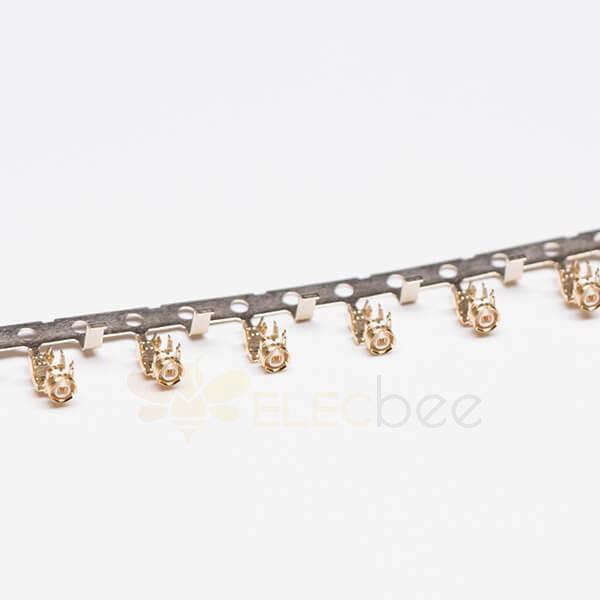In the world of electronics, connectors play a critical role in ensuring the seamless transfer of data and power between various components. Among the vast array of connectors available in the market, the IPEX connector has gained significant popularity due to its compact design and high-frequency performance. This article delves into the fundamentals of IPEX connectors, their applications, and the benefits they offer.
Understanding IPEX Connectors
An IPEX connector is a miniature RF connector used in wireless communication systems. It is also known as a micro-coaxial connector, IPX connector, MHF connector, or u.fl connector. IPEX connectors are designed to provide a low-profile, space-saving solution for connecting antennas and other RF components to circuit boards. Developed by I-PEX, a Japanese company, these connectors are characterized by their low profile and lightweight design.
IPEX connectors usually consist of a male plug and a female socket, providing a secure and reliable connection for various applications. which are connected by a flexible cable. The plug is soldered to the circuit board, while the receptacle is used to connect to an external antenna or other RF component.
IPEX connectors are characterized by their small size, with a typical height of around 1.2mm and a width of 2mm. They are also lightweight, which makes them ideal for use in compact devices.

Key Features of IPEX Connectors
Compact Design
One of the most notable features of IPEX connectors is their small form factor. With a typical mated height of 2.5 mm or less, these connectors are ideal for space-constrained applications. The compact design allows manufacturers to save valuable space on printed circuit boards (PCBs), enabling them to develop slimmer and more streamlined devices.
Excellent High-Frequency Performance
IPEX connectors are designed to handle high-frequency signals, typically up to 6 GHz. This wide frequency range makes them suitable for a variety of applications, from Wi-Fi and GPS to cellular and Bluetooth connections. The connectors' low insertion loss and excellent impedance matching ensure optimal signal transmission, reducing the risk of signal degradation and interference.
Easy Assembly and Disassembly
IPEX connectors are designed for easy assembly and disassembly, making them ideal for applications where frequent connections and disconnections are required. The male plug snaps onto the female socket with a simple push-on action, providing a secure connection without the need for any tools. To disengage the connector, a simple pull force is applied to the plug, releasing it from the socket.
Durability and Reliability
IPEX connectors are known for their durability and reliability, with a typical mechanical life cycle of more than 30 mating cycles. The connectors' gold-plated contacts ensure excellent corrosion resistance and low contact resistance, contributing to their long-lasting performance.
Applications of IPEX Connectors
Due to their versatile nature, IPEX connectors find applications in a wide range of industries and devices. Some of the most common applications include:
Wireless Communication Devices
IPEX connectors are widely used in wireless communication devices such as smartphones, tablets, laptops, and access points. They provide a reliable connection for antennas, enabling the transmission of high-frequency signals for Wi-Fi, GPS, and cellular communication.
Internet of Things (IoT) Devices
The Internet of Things (IoT) is a rapidly growing field, with an increasing number of devices featuring wireless connectivity. IPEX connectors are an ideal solution for IoT devices due to their compact design and high-frequency performance, ensuring reliable communication between devices and networks.
Radio Frequency Identification (RFID)
IPEX connectors are commonly used in Radio Frequency Identification (RFID) systems, where they enable the transmission of high-frequency signals between RFID readers and antennas. Their excellent performance and compact design make them a popular choice for this application.
Drones and Unmanned Aerial Vehicles (UAVs)
Drones and UAVs often require compact and lightweight components to maximize flight performance and efficiency. IPEX connectors offer a space-saving solution for connecting antennas and other RF components in these devices, ensuring reliable communication and navigation.
IPEX Connector Design
The IPEX connector is designed to provide a low-profile, space-saving solution for connecting antennas and other RF components to circuit boards. It consists of a plug and a receptacle, which are connected by a flexible cable. The plug is soldered to the circuit board, while the receptacle is used to connect to an external antenna or other RF component.
The IPEX plug is typically made of brass or phosphor bronze, while the receptacle is made of a dielectric material such as PTFE. The flexible cable connecting the plug and the receptacle is usually made of a thin coaxial cable or a micro-coaxial cable.
The IPEX connector is designed to operate within a specific frequency range, typically between 0 and 6 GHz. It has a characteristic impedance of 50 ohms, which is the standard impedance used in RF systems.
Limitations of IPEX Connector
While the IPEX connector offers many benefits, it also has some limitations. One of the main limitations is its power-handling capacity. IPEX connectors are not designed for high-power applications, as they have a limited power handling capacity. This means that they are typically used in low-power devices.
Another limitation of the IPEX connector is its durability. Due to its small size and delicate design, the IPEX connector can be prone to damage during handling or use. This can result in signal loss or even complete failure of the connector.
Furthermore, IPEX connectors are not suitable for applications that require frequent connection and disconnection, as repeated use can cause wear and tear on the connector.
Benefits of Using IPEX Connectors
IPEX connectors offer numerous advantages over traditional RF connectors, making them a popular choice for various applications. Some of the key benefits include:
- Space-saving design: The compact nature of IPEX connectors allows manufacturers to save valuable space on PCBs, enabling the development of slimmer and more streamlined devices.
- High-frequency performance: IPEX connectors are designed to handle high-frequency signals, ensuring optimal signal transmission and reduced risk of signal degradation and interference.
- Easy assembly and disassembly: The simple push-on and pull-off action of IPEX connectors enable quick and easy assembly and disassembly without the need for any tools.
- Durability and reliability: With a typical mechanical life cycle of more than 30 mating cycles and gold-plated contacts, IPEX connectors offer long-lasting performance and reliable connections.
In conclusion, IPEX connectors have emerged as a popular choice for various applications, thanks to their compact design, high-frequency performance, and ease of use. By understanding the fundamentals of these connectors, you can make informed decisions when selecting the right connector for your specific needs and applications.

